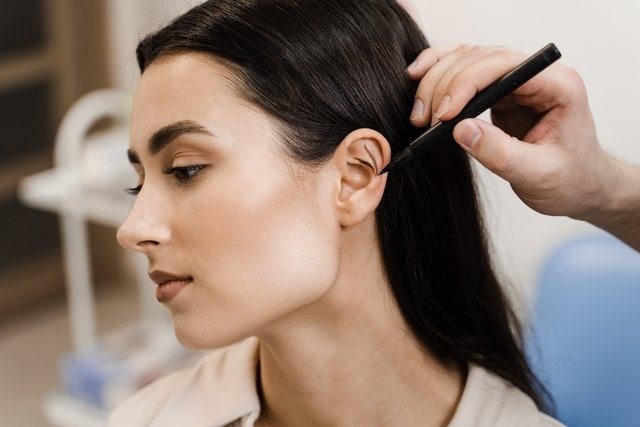Otoplasty is plastic ear surgery indicated to correct prominent ears, also known as protruding ears, deformities or congenital defects, which can interfere with self-esteem.
This surgery allows you to change the size, shape and even the position of the ear permanently, and can be done conventionally with larger cuts, or with the placement of support wires, with small cuts, being less invasive.
Otoplasty is performed by a plastic surgeon in hospitals, with local or general anesthesia, and full recovery takes around 3 months, and it is important to follow medical recommendations.

What is it for
Otoplasty aims to correct the appearance of the ears, in addition to making them more proportional in relation to the face, as it allows the doctor to change the size, shape or position of the ears.
In this way, this plastic surgery helps to improve self-esteem and quality of life, since aesthetic discomfort can interfere with socialization, especially in children.
When is indicated
Otoplasty is indicated for:
- Protruding ears or prominent ears;
- Small ears that are further away from the head, called constricted ears;
- Very large ears, called macrotia;
- Ears with different sizes;
- Deformities due to accidents or trauma;
- Conceptual defects, such as the absence of ears.
Furthermore, this surgery can also be indicated in cases of tears in the earlobes or to correct the unsatisfactory result of a previously performed otoplasty.
This surgery can be performed on adults or children when the ear cartilage is stable enough to perform the surgery, which is generally from the age of 6 onwards.
Otoplasty is performed by a plastic surgeon after a detailed clinical assessment of the ears, in order to indicate the best surgical technique.
For a complete evaluation of your ears, make an appointment with the plastic surgeon closest to you:
Taking care of your health has never been easier!
How to prepare
To prepare for otoplasty, it is important to clarify with the plastic surgeon all doubts regarding the surgery, as well as the risks, recovery and care after the procedure.
In addition, you must inform all the medicines you use frequently. In some cases, your doctor may recommend stopping anticoagulant treatment a few days before surgery to prevent bleeding.
You must also inform yourself if you have any allergies to anesthetics, medications, iodine or any other type of substance.
It is recommended to fast for at least 8 hours before otoplasty, especially in cases where sedation or general anesthesia is indicated.
Before undergoing otoplasty, you must also undergo all pre-operative exams requested by your doctor, to assess your general health status and the risk of complications. Check out the main pre-operative exams for plastic surgery.
How otoplasty is performed
Otoplasty is performed by a plastic surgeon in the hospital, using local anesthesia and sedation if necessary, or general anesthesia in the case of children.
To perform otoplasty, the doctor must follow some steps:
- Apply the topical anesthetic, leaving it to act for a few minutes. In some cases, sedation may be performed by applying medication into the vein, or general anesthesia in the case of children;
- Cover your hair with a bandage and place sterile cotton wool in the external ear canal;
- Clean the ears with antiseptics to avoid infections;
- Perform the chosen technique for otoplasty.
After completing the otoplasty, the cuts are closed with absorbable stitches and a bandage is placed on the ears, which should remain in place for approximately 48 hours, according to medical advice.
How many hours does otoplasty surgery last?
Otoplasty surgery time varies depending on the type of technique performed.
Generally, the traditional technique lasts about 2 hours. In the case of otoplasty with support wires, the duration is around 30 minutes.
Types of otoplasty
Otoplasty can be performed with different techniques, the main ones being
1. Conventional otoplasty
Conventional otoplasty is a surgical technique in which the doctor makes larger cuts in the back of the ears, to shape the cartilage and fix it to the head.
This type of otoplasty is the most common and leaves a practically imperceptible scar.
2. Otoplasty with support wires
Otoplasty with support wires, also called closed otoplasty, is performed with micro holes in the skin of the ears, not requiring cuts.
In this surgical technique, the doctor places support wires in strategic locations to remodel the cartilage and bring the ears closer to the head, improving the appearance of the prominent ear.
What is recovery like?
After otoplasty, ears may become swollen, red, or numb, which usually disappears in about 3 weeks.
Some people may have pain and, therefore, the doctor may recommend the use of analgesics or anti-inflammatories to reduce discomfort.
Normally, in the case of adults, you can return to your normal routine after 2 to 4 days, and children, after 1 week.
Generally, full recovery from otoplasty takes around 3 months, during which time medical care and recommendations must be followed.
Care after otoplasty
Recovery from otoplasty is done at home since the person is discharged on the same day of surgery, requiring some care, such as:
- Keep the dressing on for at least 48 hours, as per medical advice;
- Take painkillers or anti-inflammatories recommended by your doctor to relieve pain and discomfort;
- Avoid sleeping on your ears for at least 45 days;
- Always keep your ears clean and dry;
- Avoid touching, rubbing, scratching or picking your ears;
- Avoid sun exposure for at least 60 days after the procedure;
- Avoid physical exercise for at least 3 weeks, as advised by your doctor.
Furthermore, you must wear the otoplasty band for the first 15 days after otoplasty, for 24 hours a day, only removing it to take a shower.
After this period, you must continue using the otoplasty band for another 15 days, only at night.
How to clean the ear after otoplasty
The ears can be cleaned after removing the dressing made by the doctor, generally removed 48 hours after otoplasty.
To clean your ears after otoplasty, you should wash the area with warm water and neutral soap, or antiseptic soap recommended by your doctor.
After washing, gently dry with a clean, dry towel, keeping the skin dry at all times, and place the otoplasty band.
Possible complications
Otoplasty can cause complications such as infections of the ear cartilage or cuts, bleeding, bruising or skin necrosis, or even nerve damage in the case of otoplasty with support wires.
During surgery there is still the risk of allergy to the anesthetic, which is immediately treated by the doctor.
Furthermore, in some cases, there is still a risk that the results of the surgery will not be satisfactory, and a second surgery may be necessary to correct the defects.
When to go to the doctor
You should consult the plastic surgeon who performed the otoplasty if symptoms such as:
- Hematomas;
- Pain that worsens or does not improve with analgesics or anti-inflammatories;
- Exit of liquid, blood or pus in cuts;
- Fever or chills.
In addition, you should go to the emergency room if symptoms such as mental confusion, chest or leg pain, or difficulty breathing appear.

Sign up for our newsletter and stay up to date with exclusive news
that can transform your routine!
Warning: Undefined array key "title" in /home/storelat/public_html/wp-content/plugins/link-whisper-premium/templates/frontend/related-posts.php on line 12
Warning: Undefined array key "title_tag" in /home/storelat/public_html/wp-content/plugins/link-whisper-premium/templates/frontend/related-posts.php on line 13



